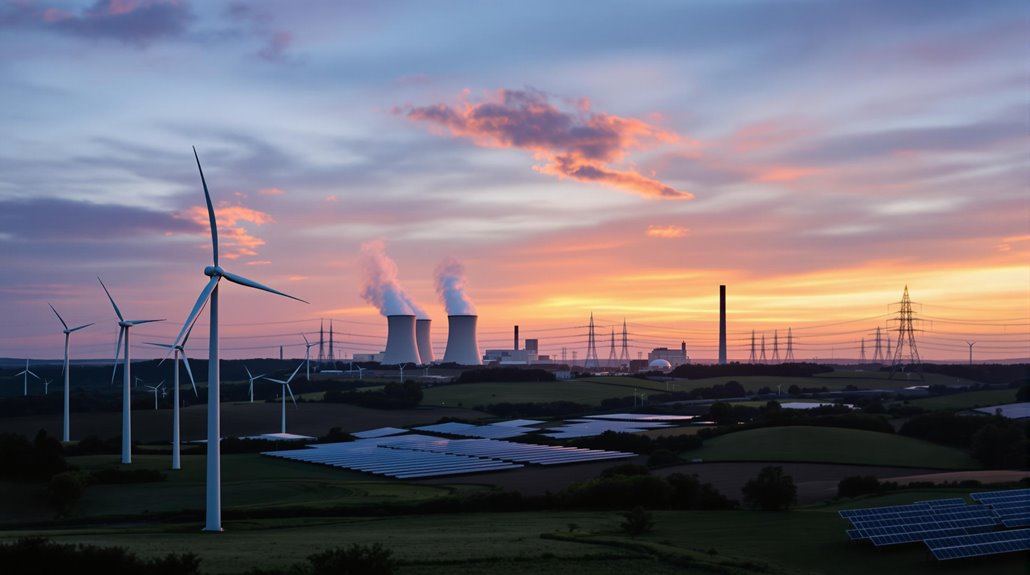What Are the Different Sources of Electricity for the Grid?

Your electricity comes from a mix of different power sources feeding into the grid. Fossil fuels like natural gas (39.8%) and coal (22.5%) provide most of America's power, while nuclear plants contribute 19%. Renewable energy sources, including wind and solar, now make up 21.5% of the nation's electricity. Each region relies on different combinations based on geography and policy. Understanding these sources helps you grasp the future of energy costs and reliability.
The Current State of U.S. Electricity Generation
As the United States continues to diversify its energy portfolio, natural gas remains the predominant source of electricity generation at 39.8%. You'll find renewable energy sources and coal neck-and-neck, contributing 21.5% and 22.5% respectively to the nation's power supply. Nuclear power plants maintain a significant role in the grid, providing 19.6% of the electricity output.
While fossil fuels still dominate the energy realm, you're witnessing a metamorphosis in how America powers its grid. The steady rise of renewable energy sources is remodeling the electricity sector, particularly through wind and solar power expansion. This shift is gradually reducing the country's dependence on traditional fossil fuels, with petroleum and other sources accounting for just 3.2% of total generation. The grid's diversification strengthens energy security and sustainability. Most power plants generate alternating current electricity because it's more efficient for transmitting power over long distances to homes and businesses.
Major Fossil Fuel Sources Powering the Grid
While renewable energy gains momentum, fossil fuels remain the backbone of America's electrical grid, with natural gas and coal providing over 62% of the nation's power supply. You'll find natural gas leading the energy mix, generating nearly 40% of U.S. electricity supply, while coal follows as the second-largest source at 22.5%.
When you look at where your electricity comes from, you'll notice that natural gas dominates the power grid due to its lower carbon emissions compared to coal. The transmission network relies heavily on these two fossil fuels, while petroleum plays a minimal role, contributing less than 1% to electricity generation. This heavy dependence on coal and natural gas in the United States' energy production creates significant challenges as the country works to shift toward cleaner electricity sources. These fossil fuel power plants generate alternating current power which is efficiently distributed over long distances through the national power grid.
Nuclear Power's Role in Base Load Generation

Nuclear power stands as a cornerstone of America's base load electricity generation, providing about 19% of the nation's power supply with exceptional consistency. You'll find nuclear plants operating around the clock, maintaining steady transmission and distribution of electricity to the grid system. According to the Energy Information Administration (EIA), these facilities achieve an impressive 93.5% capacity factor, far surpassing other power sources.
While the Federal Energy Regulatory Commission (FERC) oversees the power grid's stability, nuclear energy plays a pivotal role in maintaining reliable electricity supply. Unlike weather-dependent renewables, nuclear plants deliver consistent power regardless of conditions. Though many reactors are aging, they're indispensable for low-carbon electricity production, and emerging technologies like small modular reactors could help modernize the nuclear fleet for future grid demands. The electrical output from nuclear plants is primarily active power, which is directly converted into useful energy for powering homes and industries across the grid.
Renewable Energy's Growing Impact
Renewable energy sources are reshaping America's power setting at an astounding pace, now supplying over 21.5% of the nation's electricity. As grid operators manage supply and demand, they're increasingly turning to clean energy sources like wind power and solar installations to meet your power needs. For enhanced emergency preparedness, many facilities now incorporate solar-powered LED systems as reliable backup lighting solutions during grid failures.
Power generators are seeing exceptional growth in solar electricity production, with small-scale rooftop systems contributing 73.62 billion kWh - nearly half of all utility-scale solar output. You'll find that the grid comes with more options than ever, as community solar projects let you save on electricity bills without installing panels.
While nuclear energy and fossil fuels remain significant contributors, falling costs and incentives are making renewables an appealing choice. You can save between $20,000 and $96,000 over 25 years by switching to solar power.
Regional Variations in Power Sources

Three distinct patterns emerge when examining America's power generation terrain across regions. You'll find that the electricity system varies much across the nation's transmission lines, with each area's power sources reflecting local resources and policies. The distribution network in California relies heavily on natural gas and solar, while the Midwest's electric grid brings power primarily from wind farms, with states like Iowa leading the charge.
The network data shows the Southeast has traditionally depended on coal, though states like Florida are plunging into cleaner options. Under oversight from the Energy Regulatory Commission (FERC) and Environmental Protection Agency (EPA), the Northeast maintains diverse generation sources, balancing natural gas, nuclear, and renewables. These regional differences highlight how geography and policy shape our electricity transmission patterns across the country.
Grid Management and Source Integration
Managing America's diverse power sources requires constant choreography between multiple stakeholders and systems. The grid is a complex network that powers everything from your home to major industries, requiring careful coordination between Independent System operators and utilities. You'll find transmission and distribution systems working together to move electricity produced over long distances while maintaining reliability.
When you experience an energy crisis, it's often due to challenges in balancing supply and demand. That's why the Department of Energy works with Regional Transmission organizations to implement Energy Policy that keeps your power flowing. State regulators oversee retail rates and approve new projects, while federal authorities monitor wholesale markets. This multi-layered oversight guarantees you have reliable power when you require it, regardless of which generation sources are operating.
Emerging Technologies Shaping Electricity Production

Pioneering technological advances are revolutionizing how we produce and distribute electricity. As utilities controlled traditional power lines, the grid has come a long way with emerging energy technologies. You'll find that smart meters and AI systems now help manage the flow of electricity more efficiently, especially as we need to shift away from fossil fuels.
Battery storage systems are making wind and solar power more reliable, while microgrids let communities produce electricity locally. Electric vehicles are becoming part of the solution too, as their batteries can store and feed power back to the grid when needed. What's particularly exciting is how hydrogen fuel cells and advanced solar power systems are creating new possibilities for clean energy generation. These innovations are altering how electricity gets from source to consumer, making the grid smarter and more sustainable.
Economic Factors Driving Source Selection
Economic considerations ultimately determine which electricity sources power our grid, with utilities carefully contemplating multiple financial factors before investing in generation methods. The Energy Information Administration (EIA) shows that much of our electricity still comes from cost-competitive sources like coal and natural gas, though installing solar panels and wind turbines is becoming increasingly affordable.
While nuclear power delivers reliable, carbon-free energy, utilities must first overcome its high upfront costs. You'll find that different sources have varying economic profiles - hydroelectric and geothermal offer low operating costs but need to rely on specific geographic locations. Making sure the grid maintains high-voltage power reliably now includes considering emerging storage technologies, which can help justify investments in renewable energy by solving intermittency challenges.




